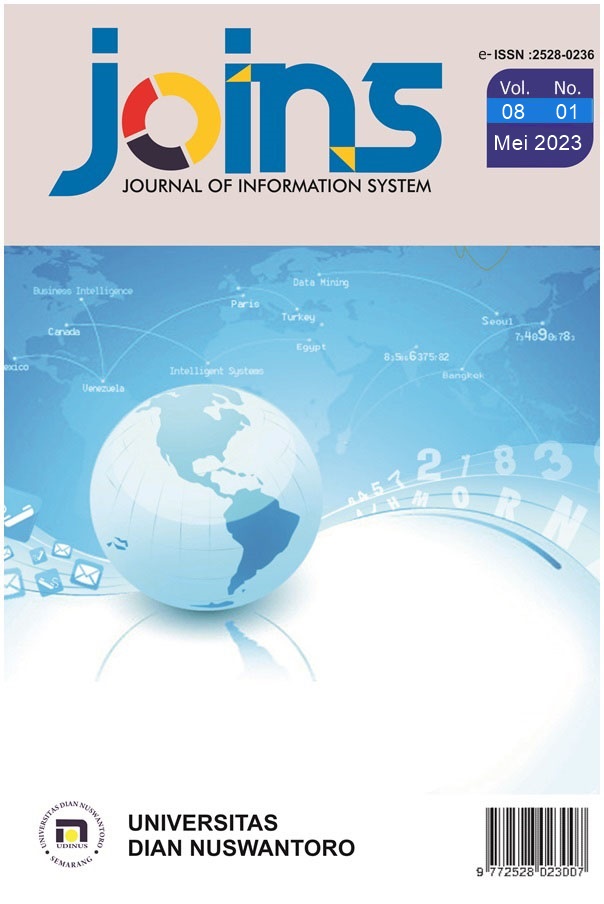The Development of web-based Cashier and Inventory Information Systems using Prototyping Model on Micro, Small, and Medium Enterprise (MSMEs) in Indonesia
DOI:
https://doi.org/10.33633/joins.v8i1.7983Keywords:
msme, cashier, information systems, inventory, prototypingAbstract
One example of information technology that has been widely applied to the business processes of a business venture is a web-based information system. Micro, Small, and Medium Enterprises (MSMEs) are productive businesses supporting the country's economy and individual companies. One of the MSMEs that will be the object of research this time is MSME Putra Anugrah Sejahtera, and This MSMEs sells premium spray paint for wheels with more than 100 colours. Around 15-20 customers daily make direct transactions at these MSMEs. In the running business processes, there are several obstacles, such as incorrect information when checking the stock of goods and recording sales transactions. This research aims to produce a web-based cashier and inventory information system to minimize errors and simplify sales and inventory transactions. System development using the Prototyping model with RDBMS MySQL was successfully developed. The results testing of systems using the User Acceptance Test (UAT) show that the resulting system follows user needs and answers the obstacles UMKM Putra Anugrah Sejahtera faces.References
L. Battistello, A. Haug, N. Suzic, and L. Hvam, “Implementation of product information management systems: Identifying the challenges of the scoping phase,” Comput. Ind., vol. 133, p. 103533, 2021, doi: https://doi.org/10.1016/j.compind.2021.103533.
R. Abrantes and J. Figueiredo, “Information systems and change in project based organizations,” Procedia Comput. Sci., vol. 181, pp. 367–376, 2021, doi: https://doi.org/10.1016/j.procs.2021.01.184.
N. Huda and R. Amalia, “Implementasi Sistem Informasi Inventaris Barang pada PT.PLN (Persero) Palembang,” J. Sisfokom (Sistem Inf. dan Komputer), vol. 9, no. 1, pp. 13–19, 2020, doi: 10.32736/sisfokom.v9i1.674.
R. S. I. Wilson, J. S. Goonetillake, A. Ginige, and W. A. Indika, “Analysis of information quality for a usable information system in agriculture domain: a study in the Sri Lankan context,” Procedia Comput. Sci., vol. 184, pp. 346–355, 2021, doi: https://doi.org/10.1016/j.procs.2021.03.044.
D. A. Darmawin and R. S. Oetama, “G-Tech : Jurnal Teknologi Terapan Teacher Performance Evaluation Decision Support System Using Simple Additive Weighting : Case Study Mentari Intercultural School,” vol. 7, no. 2, pp. 554–562, 2023.
K. Fitzgerald, L. M. Browne, and R. F. Butler, “Using the Agile software development lifecycle to develop a standalone application for generating colour magnitude diagrams,” Astron. Comput., vol. 28, p. 100283, 2019, doi: 10.1016/j.ascom.2019.05.001.
S. Chandra, R. Sutomo, and J. Wiratama, “Design And Development of Car Sparepart Sales Information System For Web-Based Using RAD Method On UMKM Sinar Seroja,” G-Tech J. Teknol. Terap., vol. 7, no. 2, pp. 494–503, Mar. 2023, doi: 10.33379/gtech.v7i2.2019.
J. Wiratama and R. Ikana Desanti, “The Development of Web-based Sales Reporting Information Systems using Rapid Application Development Method,” Ultim. Infosys J. Ilmu Sist. Inf., vol. 13, no. 2, pp. 110–116, 2022.
D. Dennis, Alan; Wixom, Barbara; David; Tegarden, Systems Analysis and Design: An Object-Oriented Approach with UML, Sixth. United States: Wiley, 2020. [Online]. Available: https://umnlibrary.vitalsource.com/books/9781119561217
S. Nabila, A. R. Putri, A. Hafizhah, F. H. Rahmah, and R. Muslikhah, “Pemodelan Diagram UML Pada Perancangan Sistem Aplikasi Konsultasi Hewan Peliharaan Berbasis Android (Studi Kasus: Alopet),” J. Ilmu Komput. dan Bisnis, vol. 12, no. 2, pp. 130–139, 2021, doi: 10.47927/jikb.v12i2.150.
Q. Lin, B. Lin, D. Zhang, and J. Wu, “Web-based prototype system for flood simulation and forecasting based on the HEC-HMS model,” Environ. Model. Softw., vol. 158, p. 105541, 2022, doi: https://doi.org/10.1016/j.envsoft.2022.105541.
D. A. Andrikov and A. S. Kuchin, “Development of a prototype of a medical information system for a clinical diagnostic center,” Procedia Comput. Sci., vol. 186, pp. 287–292, 2021, doi: https://doi.org/10.1016/j.procs.2021.04.147.
M. C. Ramadhan, J. Wiratama, and A. A. Permana, “A Prototype Model on Development Of Web-Based Decision Support System For Employee Performance Assessments With Simple Additive,” vol. 10, no. 1, pp. 25–32, 2023, doi: 10.30656/jsii.v10i1.6137.
W. W. Widiyanto, “Analisa Metodologi Pengembangan Sistem Dengan Perbandingan Model Perangkat Lunak Sistem Informasi Kepegawaian Menggunakan Waterfall Development Model, Model Prototype, Dan Model Rapid Application Development (Rad),” J. Inf. Politek. Indonusa Surakarta ISSN, vol. 4, no. 1, pp. 34–40, 2018, [Online]. Available: http://www.informa.poltekindonusa.ac.id/index.php/informa/article/view/34
C. Putri and R. Sutomo, “Evaluation of Ultima InfoSys Site Usability Using Usability Test & System Usability Scale Method,” vol. 13, no. 2, 2022.
A. Setiyadi, E. Novieastari, and D. Gayatri, “Evaluation of electronic pressure injury alarm prototype based on user acceptance testing at hospital acquired pressure injury,” Enferm. Clin., vol. 31, pp. S432–S435, 2021, doi: 10.1016/j.enfcli.2020.09.040.
Downloads
Published
How to Cite
Issue
Section
License
Authors who publish with this journal agree to the following terms:
- Authors retain copyright and grant the journal right of first publication with the work simultaneously licensed under a Creative Commons Attribution License that allows others to share the work with an acknowledgement of the work's authorship and initial publication in this journal.
- Authors are able to enter into separate, additional contractual arrangements for the non-exclusive distribution of the journal's published version of the work (e.g., post it to an institutional repository or publish it in a book), with an acknowledgement of its initial publication in this journal.
- Authors are permitted and encouraged to post their work online (e.g., in institutional repositories or on their website) prior to and during the submission process, as it can lead to productive exchanges, as well as earlier and greater citation of published work (See The Effect of Open Access).

This work is licensed under a Creative Commons Attribution 4.0 International License.






















